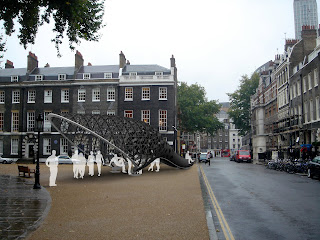The aim of this option is to test the structural capabilities of fibre-c while achieving a complex formal expression.
The pavilion is a formal expression of the growth of the DRL, starting from a small tail growing and engulfing everyone that comes to see it, reflecting the foundation of the graduate programme to the DRL’s current worldwide recognition and prestige.
The edges of the fibre-c panels are folded to create a rigid framed module. The modules are stacked and fastened together to form a structural rib, each rib is fastened together to create a rigid structural tubular system. In one direction the edges of the fibre-c modules behave as rings to transfer the weight down to the laminated timber support structure. In the other direction the edges act as lateral bracing. The infill pieces of the modules can then be milled with a pattern to create a global emergent effect as well as reducing material weight in areas of larger spans.
The challenge is to create repetition in the modules, by breaking apart the overall form into zones, each zone will use a unique module type. The module types range from square (at both ends of the pavilion) to diamond shaped (at the center of the pavilion), and infill pattern curvature goes from single (both ends of pavilion) to conical (at the center of the pavilion).
The pavilion is a formal expression of the growth of the DRL, starting from a small tail growing and engulfing everyone that comes to see it, reflecting the foundation of the graduate programme to the DRL’s current worldwide recognition and prestige.
The edges of the fibre-c panels are folded to create a rigid framed module. The modules are stacked and fastened together to form a structural rib, each rib is fastened together to create a rigid structural tubular system. In one direction the edges of the fibre-c modules behave as rings to transfer the weight down to the laminated timber support structure. In the other direction the edges act as lateral bracing. The infill pieces of the modules can then be milled with a pattern to create a global emergent effect as well as reducing material weight in areas of larger spans.
The challenge is to create repetition in the modules, by breaking apart the overall form into zones, each zone will use a unique module type. The module types range from square (at both ends of the pavilion) to diamond shaped (at the center of the pavilion), and infill pattern curvature goes from single (both ends of pavilion) to conical (at the center of the pavilion).






No comments:
Post a Comment